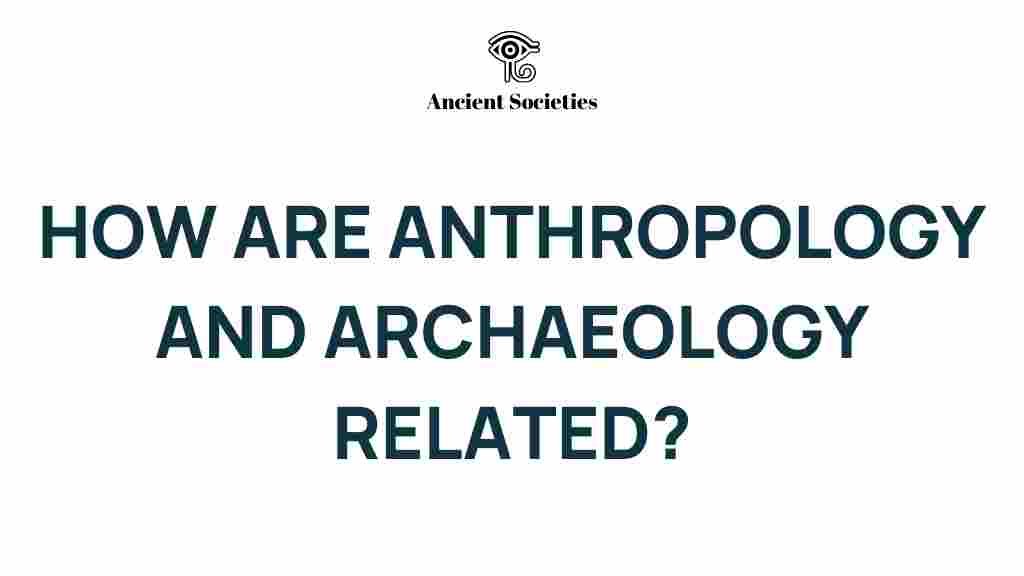Unraveling the Connection: How Anthropology and Archaeology Intertwine
Anthropology and archaeology are two fields that explore the vast tapestry of human existence, each contributing unique insights into our past. While anthropology focuses on the social and cultural aspects of humans, archaeology delves into the material remains of ancient civilizations. Together, they create a comprehensive understanding of human evolution, societal development, and cultural dynamics. This article will explore the intricate relationship between anthropology and archaeology, highlighting their roles in cultural studies, historical research, and interdisciplinary studies.
The Foundations of Anthropology and Archaeology
To understand the connection between anthropology and archaeology, it is essential to define each discipline:
What is Anthropology?
Anthropology is the study of humans, their behavior, cultures, and societies, both past and present. It encompasses several subfields, including:
- Cultural Anthropology: Focuses on contemporary cultures and their practices.
- Physical Anthropology: Examines human biological diversity and evolution.
- Linguistic Anthropology: Studies language and its social and cultural contexts.
- Archaeological Anthropology: Bridges the gap between anthropology and archaeology by studying past societies through their material remains.
What is Archaeology?
Archaeology is the scientific study of human history and prehistory through the excavation and analysis of artifacts, structures, and other physical remains. It aims to reconstruct past societies and understand their cultural practices. Key aspects include:
- Excavation: The careful digging and recording of archaeological sites.
- Artifact Analysis: Studying objects to gain insights into past human behavior and societal development.
- Site Preservation: Ensuring that archaeological sites are protected for future research.
The Interdisciplinary Nature of Anthropology and Archaeology
The intersection of anthropology and archaeology exemplifies interdisciplinary studies, where knowledge from various fields collaborates to provide a holistic view of human history. Here’s how these disciplines complement each other:
1. Understanding Human Evolution
Anthropologists study human evolution through both biological and cultural lenses. Archaeology provides crucial data on early human societies through excavation. Together, they help reconstruct the evolutionary timeline, highlighting how ancient civilizations adapted to their environments.
2. Societal Development Through Time
Archaeologists excavate sites of ancient civilizations to reveal their social structures, economies, and cultural practices. Anthropologists analyze these findings, integrating them with contemporary cultural studies. This collaboration allows for a deeper understanding of how societal development has evolved over millennia.
3. Cultural Contexts of Artifacts
Artifacts discovered through excavation are not just objects but are embedded with cultural significance. Anthropologists provide context to these artifacts, interpreting their meanings within the societies that created them. This interplay enriches historical research and enhances our understanding of ancient civilizations.
The Process of Excavation and Analysis
The process of excavation and analysis is a hallmark of both archaeology and anthropology. Here’s a step-by-step guide on how these disciplines collaborate during archaeological fieldwork:
Step 1: Site Selection
Before an excavation begins, archaeologists select sites based on historical research and anthropological insights. They consider:
- Historical records
- Topographical features
- Previous archaeological findings
Step 2: Excavation Planning
A detailed plan is developed to ensure systematic excavation. This plan includes:
- Defining excavation units
- Setting up grid systems
- Establishing safety protocols
Step 3: Conducting Excavation
Excavation involves carefully removing layers of soil to uncover artifacts. Archaeologists document every layer, while anthropologists may be present to provide insight into the cultural significance of the findings.
Step 4: Artifact Recovery and Analysis
Once artifacts are recovered, they are cleaned, cataloged, and analyzed. Anthropologists often assist in interpreting these artifacts, linking them to cultural practices and societal structures.
Step 5: Reporting Findings
The final step involves compiling findings into reports that contribute to both archaeological and anthropological knowledge. These reports often include:
- Detailed descriptions of artifacts
- Contextual analysis of the findings
- Implications for understanding human evolution and societal development
Troubleshooting Common Challenges
While the collaboration between anthropology and archaeology is fruitful, it is not without challenges. Here are some common issues and tips for overcoming them:
1. Ethical Considerations
Researchers must navigate ethical dilemmas, particularly regarding Indigenous sites and artifacts. To address this:
- Engage with local communities
- Obtain necessary permits and permissions
- Respect cultural heritage
2. Preservation of Sites
Archaeological sites are often vulnerable to damage. To mitigate this:
- Implement site management plans
- Advocate for policies that protect archaeological sites
- Utilize technology for non-invasive studies
3. Interdisciplinary Communication
Effective collaboration requires clear communication between anthropologists and archaeologists. To improve this:
- Hold regular meetings to discuss findings and methodologies
- Encourage joint training sessions
- Share resources and literature
Conclusion: The Importance of Interdisciplinary Studies
The relationship between anthropology and archaeology is vital for a comprehensive understanding of human history. By intertwining cultural studies, historical research, and insights from human evolution, these disciplines enhance our knowledge of ancient civilizations and societal development.
As we continue to explore the past through excavation and analysis, the collaboration between anthropology and archaeology will remain essential. This interdisciplinary approach not only enriches our understanding of human history but also fosters a greater appreciation for the complex tapestry of cultures that have shaped our world.
For further reading on this topic, consider visiting this resource for additional insights into archaeological practices and their cultural implications.
This article is in the category Archaeology and created by AncientSocieties Team
